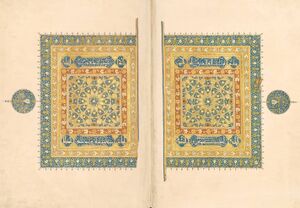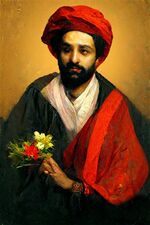Lisan al-Hikma
| Lisan al-Hikma | |
|---|---|
| لِسان الحِكْمة | |
 | |
| Information | |
| Religion | Esoteric Shi'ism |
| Author | Al-Sayyid al-Mu'alim |
| Language | Riysan |
| Period | C. 1070 |
| Chapters | 12 |
| Verses | 2,495 |
| Esoteric Shia scripture |
|---|
 |
| From Al-Sayyid al-Mu'alim |
| From the Auxiliary Imams |
The Lisan al-Hikma is one of the central religious texts of Esoteric Shi'ism. Completed in 1070 by Al-Sayyid al-Mu'alim, dubbed 'The Teacher' by early Esoteric Shias, the Lisan al-Hikma contains theological expositions, essays, prayers, parables, jurisprudential ordinances, mystical treatises and historical accounts. The book is written in the form of a direct address to the reader, as demonstrated by the constant use of exhortative phrases such as "O thou!", "O people!", "O beloved of the All-Merciful!" and so on. Esoteric Shias consider the Lisan al-Hikma to be the holiest book of the religion. It is divided into 12 kalimas, each consisting of varying numbers of verses, totalling at 2,495.
In 1041, Al-Sayyid al-Mu'alim announced his claim as the deputy (wakil) or gate (bab) of the Hidden Imam, the messianic figure believed by Esoteric Shias to make a return on the day of judgment. In so doing, he declared himself to be the symbolic return of the Hidden Imam in his capacity as the Hidden Imam's mouthpiece and the recipient of his wisdom and teachings, thus heralding the symbolic advent of the Day of Resurrection. The Shias of Muzdatijer held the belief that the Hidden Imam would reveal a new scripture and a new cause, a prophecy that Esoteric Shias claim to have been fulfilled by Al-Sayyid al-Mu'alim. For this reason, the Lisan al-Hikma is considered by Esoteric Shias to be divine revelation, instituting a new religion. The frequent claims of revelation throughout the Lisan al-Hikma, as evidenced by the book's insistence on calling itself a "revelation", or wahy, have been a constant source of contention between Esoteric Shias and Zahiri Shias since its original publication, and have also been cited as a reason for the excommunication of Esoteric Shias by Sunni denominations in the Sythithian milieu.
The Lisan al-Hikma presents itself as a book of mystical revelation, intended for the believer as a guidance towards attaining true gnosis, or Irfan. The chapters of the book all begin with doxological verses and end with a formulaic salutation addressed to Abraham, past prophets recognised by Esoteric Shi'ism, and the Hidden Imam. The issue of voice is one of the book's most vexing issues, as there is disagreement over who is speaking the words of the Lisan al-Hikma. The official position of the Auxiliary Imamate is that the voice is purely that of Al-Sayyid al-Mu'alim acting as the Hidden Imam's representative, but an 11th-century group of Esoteric Shias based in Jartasti, known as the Brethren of Secrets (Ikhwanu'l-Asrar), believed that the speaker in the Lisan al-Hikma is the Hidden Imam himself. In a 2017 letter to the worldwide Esoteric Shia community, the incumbent Auxiliary Imam has reasserted the official stance of the Auxiliary Imamate and the Shia Convocation, but allowed for a diversity of opinion in this regard as the issue of voice is of minuscule importance and has no bearing on the essence of the book's message.
Originally written in Riysan, the Lisan al-Hikma was translated into the Maqtajeri language sometime in the 1080s, a decade after its first publication. In the 12th century, it was translated into the Anjanian language for the first time. The Anjanian translation served as the source for its subsequent translation into the Latin language during Exponential rule in what is now Hindia Belanda, a period which saw the translation of the Qur'an in Latin, and into Dutch during company rule. The first English translation of the Lisan al-Hikma was published at Pulamula in 1834 and has since been re-translated from the original Riysan numerous times, the most recent being the authoritative Mount Ilias Edition of 2021 translated by Tahira Visser and Samuel Amatmoekrim.
History
Proclamation of a new religion and authorship
The Lisan al-Hikma was authored by Al-Sayyid al-Mu'alim, a religious figure who lived in what is now Jartastı from 1016 until 1093 CE. Al-Sayyid al-Mu'alim began his ministry in 1041 at the age of 25 when he initially attracted a considerable following amongst the Shias of Maqtajer by giving frequent sermons imbued with mysticism at different religious gatherings around the region. Early in his ministry, Al-Sayyid al-Mu'alim authored many writings in which he appears to identify himself as a deputy (wakil) of the Hidden Imam, a claim that drew the ire of prominent Muzdatijeri Shia scholars at the time. Despite the controversy surrounding his claim, Al-Sayyid al-Mu'alim and his growing body of followers were largely ignored and tolerated by other Shias of Muzdatijer until 1045 CE, 4 years into his ministry, when, during a public sermon at a town in eastern Jartastı, he became involved in an open debate with Shaykh Nasir, a prominent Shia scholar opposed to Al-Sayyid al-Mu'alim's ministry, on certain points of theology, the role of scripture and the importance of esoteric interpretation, amongst others. It was during this lengthy episode that Shaykh Nasir openly excommunicated Al-Sayyid al-Mu'alim for the first time, calling him and his followers 'deserters' and 'traitors' to the cause of the Imams for having espoused views that Shaykh Nasir considered too divergent. This episode was widely recorded in writing by contemporanous witnesses on both sides of the conflict. According to extant accounts, Al-Sayyid al-Mu'alim was able to refute all of Shaykh Nasir's arguments during the lengthy debate, culminating in the latter's excomunnication of the former and, ultimately, the Shia Schism of Sythith.

At this point, the Shias of Muzdatijer were split into two. The smaller, mystical-oriented faction was that of Al-Sayyid al-Mu'alim, which would become the Esoteric Shias of today and the largest of the Shia denominations. The larger group at the time was the remainder of the Shia community of Muzdatijer who remained unconvinced of Al-Sayyid al-Mu'alim's ministry. The nascent Esoteric Shia community experienced repression and persecution by the more numerous Zahiri Shias, prompting many Esoteric Shias previously living in Zahiri-majority settlements to leave their homes and disperse themselves throughout Muzdatijer. Many Esoteric Shias at the time found refuge in Yazidi-majority cities and towns, whilst others travelled to as far as the neighbouring Duchy of Srambi in modern-day Hindia Belandan province of Malaya.
Al-Sayyid al-Mu'alim spent the rest of his life as an itinerant leader of the Esoteric Shias, travelling from one settlement to the next. In the 1070s, he started to gradually reveal the contents of the Lisan al-Hikma in a series of sermons delivered to the various Esoteric Shia communities in Muzdatijer and Srambi. These sermons were memorised by the Esoteric Shias and put into writing as loose folios by scribes in Al-Sayyid al-Mu'alim's employ.
Compilation
The general consensus amongst modern scholarship is that the Lisan al-Hikma was compiled into a single book during the lifetime of Al-Sayyid al-Mu'alim, sometime in the 1070s. A minority of 21st century scholars, however, maintain that the Lisan al-Hikma was compiled at least two decades after Al-Sayyid al-Mu'alim's death in 1093, likely by a group of Esoteric Shia scribes in Jartasti, Maqtajer, who had put into writing the sermons that would become the contents of the book. The 19th century Noordenstaater-born scholar Liefje Hoekstra famously theorised in
The Iliasan recension
In 1897, the Shia Convocation's Department for the Preservation of the Sacred Texts discovered a copy of the Lisan al-Hikma containing verses and chapters not present in the book in current circulation during the department's relocation to its new building on the western slopes of Mount Ilias, raising questions as to the authenticity of the scripture in current circulation. It was concluded by the Auxiliary Imamate, however, that the divergent copies were made by
Translations
Significance in Esoteric Shi'ism
| Part of a series on | |||||
| Esoteric Shi'ism | |||||
|---|---|---|---|---|---|
 | |||||
| The Seven Figures | |||||
|
|||||
| The Seven Principles | |||||
|
|||||
| Beliefs and practices | |||||
| Place of worship | |||||
|
|||||
| Holy days | |||||
|
|||||
| Texts | |||||
| Governance | |||||
As divine revelation
As an exegesis of past scriptures
As authoritative guidance
Arrangement
The 12 chapters, or kalimas, of the Lisan al-Hikma are arranged according to an instruction written by Al-Sayyid al-Mu'alim, the original copy of which is in the possession of the Commonwealth Collection Trust. The chapters are not sorted by order of length.
Contents
Monotheism
Admonishment to the Shias of Muzdatijer
Cosmology
Cosmogony
Eschatology
Charity
Exhortations
Interpretation
Exegeses
The Lisan al-Hikma has been an object of many works of interpretation, a great number of which is considered authoritative by Esoteric Shias. The most prominent exegesis of the Lisan al-Hikma is the Elucidation of the Saying of Wisdom (Al-Bayan fi'l-Lisan al-Hikma) by the ninth Auxiliary Imam, Siyyid Mustafa. Interpretations on individual chapters and verses of the Lisan al-Hikma have also been produced throughout Esoteric Shia history by scholars and theologians.
Hermeneutics
Printing
Notes
References
Further reading
External links
- Mount Ilias Authoritative Translation (English translation of the Lisan al-Hikma)
